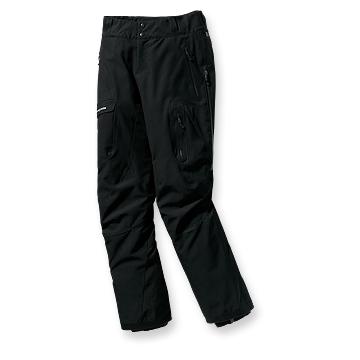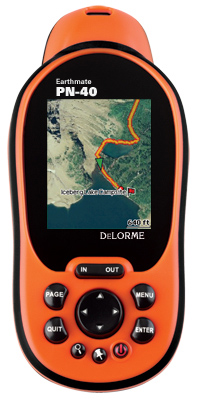 About the DeLorme PN-40 GPS
About the DeLorme PN-40 GPS
The PN-40 is DeLorme's premier GPS offering topographical mapping, street auto-routing, and tons of downloadable maps and imagery to get you the information you need. In addition to the world base map, DeLorme ships all GPS units with three discs that contain 1:100k hybrid road/topographical maps, making them the only company to ship maps of this detail with each unit. In addition to the topographical maps included, DeLorme offers aerial imagery, NOAA nautical charts, satellite imagery, and the super detailed 1:24k, 7.5 minute USGS quads all via the included Topo USA. The PN-40 is 'ruggedized' and certified to to withstand quite a beating. The PN-40 is certified to the IEC IPX7 standard for waterproofing and is sealed to protect the unit in high humidity and extreme cold environments. The PN-40 also sports an barometric altimeter and 3-axis compass eliminating the need to hold to the PN-40 flat to take compass readings. While neither of these items are absolute necessities, they do come in handy. (Lower model GPS units that don't include these features need to be moving in order to determine direction as they are based on position not orientation). The on-board compass eliminates the motion requirement and allows you to determine which way to face before you move -- it also allows you to shoot bearings for triangulation. It's important to note the DeLorme PN-40 and PN-30 are identical with the exception of the fact the PN-30 does not have the altimeter or the compass. The PN-40 has 500MB of internal storage (7.5GB on the SE model) but an SD card slot allows expansion up to 32GB which should be plenty of room for maps, imagery, tracks, and waypoints.
First Impressions of the DeLorme PN-40 GPS
We were a bit disappointed that there was no Topo USA for Mac, only PC. Although transferring of maps is possible, it's not as straightforward as just having a Mac version available. We'll discuss the detailed method of transferring maps to your PN-40 using a Mac in the full review, but for now just know that it is possible. We've also found a way to add custom tracks to this GPS using your Mac (PC users will still use Topo USA). We'll have those details as well in the full review. 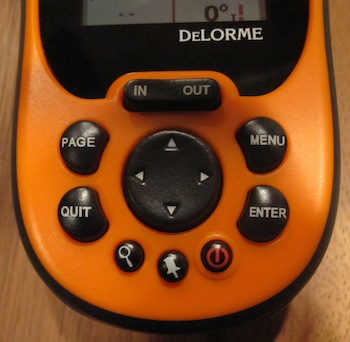 Out of the box, the PN-40 looks like a standard handheld GPS. Navigation of the device is done using the arrow and function buttons beneath the screen, and all the functions are pretty straightforward. The first time you start the device, it will take a few minutes to get a fix. This can be sped up by using the Menu->Set Current Location function. We were able to get a good initial fix in about 3 minutes on average. Once you have the initial fix, starting up the GPS 'warm' gets your location in usually 20 seconds or less. To get the PN-40 fired up, the batteries are installed by removing the cover, which is screwed on with two small D-rings. If you want to use the SD card, you'll need to remove the batteries to get to it. We'd prefer a micro-sd card slot that's accessible on the side (like some Garmin units), but it's not a big deal since you won't need to access the SD card very often. Once your maps are all installed (we loaded the Colorado maps to the SD card directly), you'll be ready to go. The maps include topo information, roads, and points of interest (POIs).While the PN-40 supports turn by turn navigation, it's not as robust as what you'll get from a dedicated in-car nav device, or even some other handheld devices. We really expect the strengths of the PN-40 to shine in the outdoors. This unit isn't really meant for road use (although it appears to work for that as well). The topo maps, the ability to load tracks (and convert them to routes), and the availability of additional map data means that this unit should be well suited for any adventure.
Out of the box, the PN-40 looks like a standard handheld GPS. Navigation of the device is done using the arrow and function buttons beneath the screen, and all the functions are pretty straightforward. The first time you start the device, it will take a few minutes to get a fix. This can be sped up by using the Menu->Set Current Location function. We were able to get a good initial fix in about 3 minutes on average. Once you have the initial fix, starting up the GPS 'warm' gets your location in usually 20 seconds or less. To get the PN-40 fired up, the batteries are installed by removing the cover, which is screwed on with two small D-rings. If you want to use the SD card, you'll need to remove the batteries to get to it. We'd prefer a micro-sd card slot that's accessible on the side (like some Garmin units), but it's not a big deal since you won't need to access the SD card very often. Once your maps are all installed (we loaded the Colorado maps to the SD card directly), you'll be ready to go. The maps include topo information, roads, and points of interest (POIs).While the PN-40 supports turn by turn navigation, it's not as robust as what you'll get from a dedicated in-car nav device, or even some other handheld devices. We really expect the strengths of the PN-40 to shine in the outdoors. This unit isn't really meant for road use (although it appears to work for that as well). The topo maps, the ability to load tracks (and convert them to routes), and the availability of additional map data means that this unit should be well suited for any adventure.
What We're Looking for in the DeLorme PN-40 GPS
We will be testing the PN-40 in many different situations including rock climbing, hiking, off-roading, and around the park. We'll be looking at quite a few things as we test the PN-40, from battery life and screen readability to GPS satellite sensitivity in cloud cover and resistance to the elements. Make sure you subscribe to our RSS Feed so you don’t miss the final review.
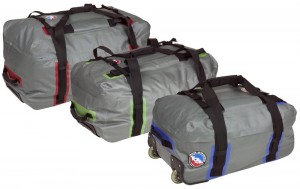 About the Big Agnes Stagecoach Duffel
About the Big Agnes Stagecoach Duffel
The Stagecoach is a waterproof, wheeled duffel for those needing to carry a good deal of gear. The Stagecoach comes in three sizes, small (54 liters), medium (85 liters), and large (150 liters) ensuring there is a size for every need. The features from the Big Agnes website are below:
- Durable, waterproof nylon with welded seams
- Heavy duty plastic, tractor-style wheels on medium and large sizes. Polyurethane inline skate wheels on small size
- Improved flip top lid opens fully
- Light gray interior so you can see your stuff
- Durable aluminum frame with extending lockable handle
- Two large interior zippered pockets
- Independent backpack strap system and external compression straps
- Water resistant, molded plastic zipper and soft rubber grab handles
- Size small meets most airline carry-on size regulations
First Impressions of the Big Agnes Stagecoach Duffel
When the Big Agnes Stagecoach duffel I ordered arrived the other day I thought for a few moment maybe it was too big. With the ability to hold 150 liters the large duffel can swallow enough gear for even the most ambitious expeditions. It's going to be a challenge to fill. I am a big fan of the backpack straps that are on the Stagecoach although I won't be trying the shoulder it fully loaded. The quality seems to be top notch and don't anticipate any problems with the construction or materials. I would have liked to see either a waterproof zipper or a flap to cover the zipper (or both) for the days where your Stagecoach sits in the elements for hours. The one other feature I would have liked is an internal frame to give more shape to the duffel similar to that of the North Face Rolling Thunder.
Up Next for the Big Agnes Stagecoach Duffel
The Stagecoach is currently being packed for a trip to Costa Rica in a couple weeks. A few days after my return from Costa Rica I'll be off to Peru. In each case we'll be abusing the Stagecoach to see how it holds up and meets our needs. We will of course keep you informed. Make sure you subscribe to out RSS Feed so you don’t miss the final review.
I’m a huge fan of fitness. I think eating right and regular intense exercise are the cornerstones of preparing for adventures and life in general. Plus, as a member of the US Armed Forces, I’m required to stay physically fit. My fitness activities range from light days at the gym to hard core circuit courses. I usually prefer to get my cardio workouts on the trails in and around Colorado Springs, usually with a few pounds of gear strapped to my back. Unfortunately I don’t always have time to get out for cardio, so I have to rely on what the local fitness center has to offer. While stair climbers, elliptical machines, and stationary bikes all work fine for cardio, I know that the best workout in a short time is running. The problem is, I REALLY don’t like running. I’ve had to run for time pretty regularly since I joined Civil Air Patrol over 20 years ago, and I’ve never liked it. When I first joined the Air Force, my run times were average at best, I’ve never been a fast runner. As I’ve aged, I’ve developed minor knee irritations that have required a brace on occasion, which has definitely slowed my run times. While I still meet the standards for the AF, I’ve really felt that I’ve been held back a little.  Last year a friend of mine posted on Facebook about a not-so-new running ‘shoe’ called the Vibram Five Fingers.
Last year a friend of mine posted on Facebook about a not-so-new running ‘shoe’ called the Vibram Five Fingers.
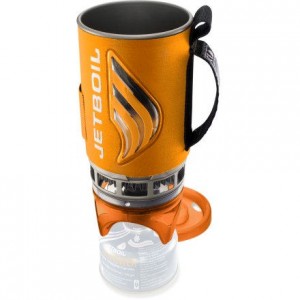 About the Jetboil Flash
About the Jetboil Flash
The Jetboil Flash in the latest innovation from Jetboil. Like the Jetboil Personal Cooking System (PCS), the Flash is an integrated cup, stove, and heat exchanger. The integration of all the components make the Jetboil systems extremely efficient. According to Jetboil the Flash will boil two cups of water in an amazingly fast two minutes. The features and specs from the Jetboil website:
- 1.0 Liter FluxRing® cooking cup with insulating cozy, featuring Flash color-change heat indicator
- Adjustable stainless steel burner with push-button “through-cup” igniter
- Drink-through lid and insulating bottom cover/measuring cup
- Tripod base for added stability
- Available in Gold, Violet, Sapphire and Carbon
- Weight: 14 oz (397 g)
- Volume: 32 oz (1 Liter)
- Boil Time: 16 oz (1/2 Liter) = 2 minutes
- Water Boiled: 12 Liters per 100g Jetpower canister
- Dimensions: 4.1” x 7.1” (104 mm x 180 mm)
Differences Between Jetboil PCS and Jetboil Flash
On initial inspection, the differences between the Jetboil PCS and the Flash seemed fairly cosmetic to me so I inquired further. Ric Pratte from Jetboil's PR firm gave me some more in-depth information on the updates.
The technical difference between PCS and Flash is in the burner. [The] Flash burner control is a wire "bale", which is easier to access and operate than [the] knob on the PCS. The Flash igniter is low profile and comes up through the burner head, which means its less likely to be damaged than the PCS igniter. The burner head is solid stainless steel, as compared to the mesh head on the PCS, which is subject to shrinking over time and then falling out. Also, the Flash comes with a tripod stabilizer, which is a $10 retail value.
First Impressions of the Jetboil Flash
The Jetboil Flash is a pretty impressive piece of equipment. Stowed, all components fit within the Flash's 32oz. cup for easy transport. The Flash is a bit heavier than the homemade alcohol stove I currently use for warm weather pursuits but the Flash's simplicity and quick boils will no doubt be key during the colder months. In the couple boils I did to test the Flash did indeed get water to a boil very quickly, and the heat indicator on the side is a nice (though not altogether necessary) touch -- it turns orange when the water reaches 140°F. I look forward to giving the Jetboil Flash a good workout in the coming months.
What We're Looking for in the Jetboil Flash
With the Jetboil already being used by many of the top mountaineers on some of the highest peaks in the world (see Peter Whittaker mention the Jetboil as a mountaineering game changer) we anticipate that the Jetboil Flash will be an asset on our backcountry endeavors in slightly less demanding conditions.
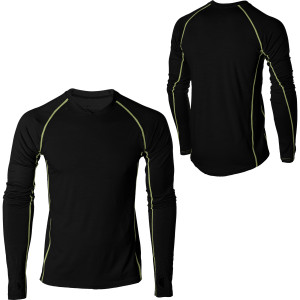 This lightweight wool next to skin base layer should be an essential for anyone doing cold weather activities. This Athletically fitted crew neck shirt has long sleeves and offers thumb holes to keep it getting bunched up under other layers. Even giving your hand a little extra heat inside gloves. All of Stoic shirts are somewhat stylish and would look just fine spending time at the bar after making your final tracks of the day. Although I would probably wear another shirt or a vest over it to keep from being “That Guy.” But at least it won’t smell bad when you offer to buy the cute ski bunny a beverage.
Design: Ultra-fine Merino Wool base layer
Retail: $59 (Buy)
Why it’s hot:
This lightweight wool next to skin base layer should be an essential for anyone doing cold weather activities. This Athletically fitted crew neck shirt has long sleeves and offers thumb holes to keep it getting bunched up under other layers. Even giving your hand a little extra heat inside gloves. All of Stoic shirts are somewhat stylish and would look just fine spending time at the bar after making your final tracks of the day. Although I would probably wear another shirt or a vest over it to keep from being “That Guy.” But at least it won’t smell bad when you offer to buy the cute ski bunny a beverage.
Design: Ultra-fine Merino Wool base layer
Retail: $59 (Buy)
Why it’s hot:
- Athletic Cut
- Thumb Holes
- Better Looking Than Plain Base Layers
- Thumb Holes Could Be a Tad Bigger
- Lighter colored fabrics are a little see though
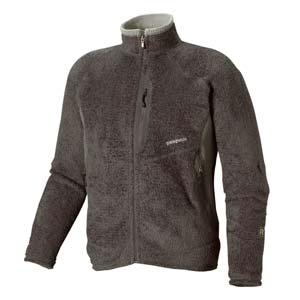 About the Patagonia R2 Jacket
About the Patagonia R2 Jacket
Along with my Patagonia Primo Jacket and PantsI received an R2 jacket to serve as my insulation layer. Like I said in that article I have gotten a late start in testing my new ski gear but I plan on giving it a run for it's money in the coming months. Before we get too involved let's take a look at the R2 jacket features from the Patagonia website:
- Highly technical R2 fabric is light, stretchy and compressible, with great breathability
- Insulating long fibers alternate with dense, supportive short fibers to optimize insulation and reduce bulk
- Directional knit wicks moisture and speeds dry time
- Inner collar lined with R1® fabric (made with recycled polyester) for next-to-skin comfort; collar and protective chin flap lined with R1 fabric (made with recycled polyester) for next-to-skin comfort
- Low-bulk R1 fabric cuffs
- Pockets: one chest and zippered handwarmers; zippers all welded and reinforced with Supplex® for snag-free operation
- Shoulder seams set forward for pack-wearing comfort
- R2® shell: 7.4-oz Polartec® Thermal Pro® 100% polyester (40% recycled) fleece. R1® panels: 6.5-oz Polartec Power Dry® 93% polyester (60% recycled)/7% spandex. Recyclable through the Common Threads Recycling Program
- 419 g (14.8 oz)
- Made in Colombia.
First Impressions of the Patagonia R2 Jacket
The first thing I noticed when I pulled the R2 jacket out of the box was how light it was, even for a fleece. The high loft of the soft polyester fleece seems ideal for great compressibility while providing great insulation qualities. It's quite soft too! It is a shame that Patagonia hasn't been able to get a lightweight fleece such as the R2 with wind resistant properties like the R4 but I suppose that's the trade-off. That said, the R2 jacket seems to be constructed to the high standards that is common of Patagonia. I did have a few issues when I wore the jacket around the neighborhood for the first time. The fit seems to be a little weird with a tight fit in the shoulders and arms. Perhaps I was wearing a bulky sweater, but it still struck me as odd. The second problem I have is similar to the many jackets sporting a napoleon pocket: when reaching to unzip the jacket I tend to grab the pocket zipper instead. It's really a love hate relationship with napoleon pockets in general. Otherwise there seems to be no problem with materials, design, or construction.
What We're Looking for in the Patagonia R2 Jacket
In the next few months we will be testing the Patagonia R2 jacket under hard shells while skiing both downhill and AT, on it's own while climbing in the Gunks, and of course we will be wearing it around town after a day of hiking. We expect the R2 jacket to perform as advertised with it's light weight, compressible, insulation goodness. Make sure you subscribe to out RSS Feed so you don't miss the final review.
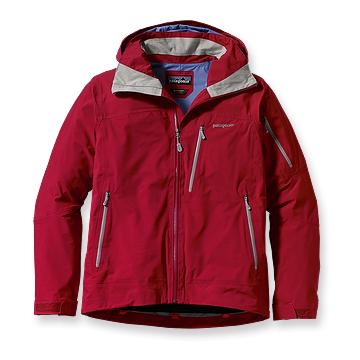 About the Patagonia Primo Jacket and Primo Pants
About the Patagonia Primo Jacket and Primo Pants
I received my Patagonia Primo Jacket and pants the other day and although I am getting a late start with my ski gear, I plan to give the Primos a run for their money in the coming weeks. With trips planned to Vermont, Utah, and Colorado I'll be sure to test to the Primo Jacket in some challenging situations. The Primo jacket also comes in a down insulated version (not reviewed here as I am not a big fan or insulation and shells combined). Let's have a quick look at some of the features of the Primo Jacket from the Patagonia website:
- Lightweight, yet durable 3-layer 4.2-oz stretch-woven nylon with H2No® waterproof breathable barrier and Deluge DWR finish
- Fixed helmet-compatible hood with single-hand drawcord pull
- Drop collar with high neck to provide protection from winds and snow
- Coated, water-repellent zippers for center front, hand pockets, and pit zips
- Pockets: left chest with electronic pocket inside, two handwarmer, two interior drop in
- Pit zips
- Fully featured, zip-off, stretch powder skirt with webbing loops to attach to pants, and pass window
- Shell: 4.2-oz 50-denier 100% stretch-woven nylon with a waterproof/breathable H2No® barrier and Deluge® DWR (durable water repellent) finish. Powder skirt: 2.3-oz 100% all-recycled polyester plain weave
- 652 g (23 oz)
- Made in Vietnam.
- And the features for the Primo pants from the Patagonia website:
- Lightweight, yet durable 3-layer 4.2-oz stretch-woven nylon with H2No® waterproof/breathable barrier and Deluge® DWR (durable water repellent) finish
- Snap-closure waistband
- Interior waistband and adjustments lined with soft, brushed tricot
- Pockets: two handwarmer, one right thigh with coated water resistant zippers
- Scuff guards to protect pant cuffs
- Fully-featured gaiters with gripper elastic, adjustable cam buckles and integrated drawcord
- 3-layer, 4.2-oz 50-denier 100% stretch-woven nylon with a Deluge® DWR (durable water repellent) finish
- 485 g (17.1 oz)
- Made in Vietnam.
First Impressions of the Primo Jacket and Primo Pants
The quality of the Primos are nothing less than what we have come to expect out of Patagonia. All seams are perfectly taped, the stitching is top notch, the zippers work perfectly, in fact there doesn't seem to be a single blemish on the jacket or pants. The Primos are certainly on par with the best ski/snowboard clothing currently on the market. As a plus, when we put the Primo jacket (small) on the scales it came in at just 21 3/4oz and the Primo pants (medium) came in at 16 3/4oz. both on par with advertised weights.
What We're Looking for from the Patagonia Primo Jacket and Primo Pants
For the premium that is charged for the Primo jacket and Primo pants we expect them to perform superbly in very tough conditions. We'll be on the slopes in Vermont and Utah, late season AT skiing in Colorado, climbing in New Mexico, and torturing ourselves with downpours in between. We're expecting the Primo to keep us protected from the elements as well as allowing water vapor from our sweat to escape so as to not create a sauna inside the shell. All of this is expected of the Primo in widely varying conditions. It's a tall order, yes, but that is the reason the Primos were designed. Make sure you subscribe to out RSS Feed so you don't miss the final review.
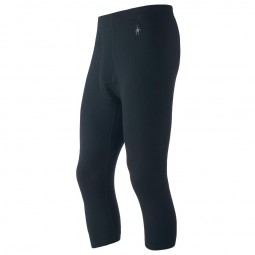
I can’t believe it took me so long to get something like the Midweight Boot Top Bottom. I’ve used them countless times in only their first season. Incredibly comfortable they have a covered elastic waistband and flat lock seams. They are great under ski pants, climbing pants, or jeans while sticking it out though a cold fall football game. The length overlaps ski socks by a couple of inches and gives you one less thing to have to deal with around your ski boots or climbing shoes.
Quick Review:
Design: Ultra-fine Merino Wool base layer Weight: 7oz Retail: $70 (Buy) Why it’s hot:- Exceptionally Comfortable
- Length doesn’t interfere with ski boots
- I only have one pair

I’ll never go back. I have spend all of my adventure life wearing Patagonia poly-capaline. I didn’t know it could get better, but I was wrong. Not that the synthetic base layers are bad, mine still see some use. But there really is no comparison. The Smartwool’s 100% wool Sport STS Crew is just in another league. It’s has a considerable better feel next to your skin, is more formfitting and also allows for better range of motion. Made with flatlock seams it’s easy to forget your wearing it. However, my favorite thing about the Sport NTS Crew is length of the sleeves. I am 6’1” tall 175lbs and have a 3 ½” ape index. Finding any long sleeve shirt with the proper sleeve length usually means going up a size and having to accept swimming in it. Last but surely not last, it doesn’t smell bad, ever. In contrast my Patagonia base layers are worn with sleeves pulled up to my forearms and have to be kept at a distance as no amount of washing or fabreeze can rid them of their stink. I am anxious to see how well it holds up to wear and tear. I’m not worried about having it under my ski gear, but climbing off-width desert crack during our annual fall or winter desert climbing trips. Look for updates. Design: Ultra-fine Merino Wool base layer Weight: 10.2oz Retail: $80 (Buy) Why it’s hot:
- Incredibly Comfortable
- Athletic Cut With Long Sleeves
- Doesn’t Smell
- Pricier Than Synthetic materials.
- Durability?
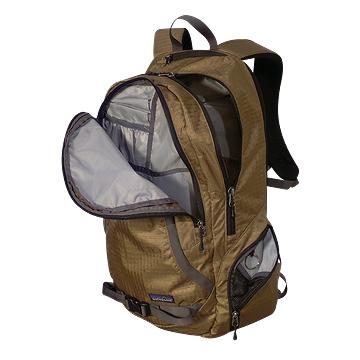
The Patagonia Crosstown backpack is a great pack for the daily commuter or the traveler on the go. With space for a large collection of papers, magazines, or books, it seems to be the perfect size for the daily grind or a day hike. A smaller section for items that you need quick access to rounds out the mass storage areas, although the advertised office organizer leaves something to be desired. The Crosstown sports numerous small pockets providing a place for loose change, cell phones or any other small item you can think of. From the obvious pocket on the top, to the one on the side, to the obscure pocket on the inside of the outer pouch, there are surely enough pockets to lose something in. The top pocket came in particularly handy while removing all the metal objects from my pockets while standing in the security line at the airport. It does however, lack an earphone hole for those that like to keep and iPod in there. That said, the greatest feature is the laptop pouch on the backside of the large pouch. It's big enough to accommodate a laptop up to 17" and keep it well secured. The laptop pouch is suspended to keep your laptop from touching the ground when you set the pack down and is sufficiently padded for extra protection. The pack does have outside mesh water bottle pockets but these never seem to work out as good as the designers intended. I like to use the outside pouch for items I need quick access to, but I'm selective in doing so as there is no security to keep prying hands out, a problem for those commuting in high density areas. The crosstown is also coated with a DWR (durable water repellent) to keep your wares dry when caught in an unexpected shower.
Quick Info
Design: Commuter Backpack Capacity: 26l (1,597 cu/in) Weight: 1lb. 11oz. Retail: $100 (Buy) Why it’s hot:- Laptop pouch
- Lots of pockets
- Great size
- DWR
- No security on outside pouch
- No earphone jack
- Mesh pocket doesn't work so well
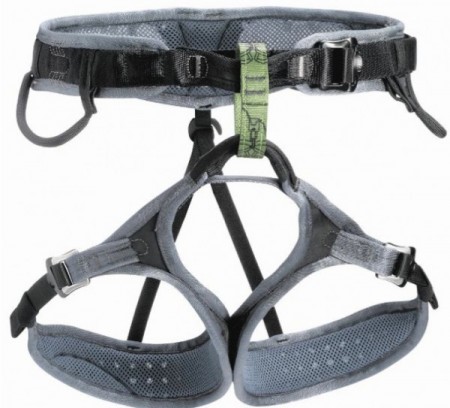
I've climbed in Petzl harnesses for years. They were the first to the market with the auto double back buckles and I loved the ability to loosen up my leg loops while hanging out between climbs and belays. When it was time to retire my old Petzl Calidris I began shopping strictly for a Petzl harness and ended up with the Adjama. I was thrilled with the light weight and how incredibly breathable the harness is. There is nothing better for sport climbing during the summer months. The unmolded rear gear loops are great when wearing a backpack and your harness. While the harness is not excessively padded the fit is excellent. I have never experienced any pressure points while hanging, even for long periods of time. If you know anything about the Calidris harness it had two waist belt buckles so no matter what you were wearing you could always have the harness centered on you body. I was spoiled. The Adjama only has one waist belt buckle and most of the time it centered and fits well; however, the occasional day of Ice climbing led to an acceptable but less than desired fit. Like I said I was spoiled. Most harness only have one buckle. I miss the twin buckles and the ability to completely remove the harness by unthreading all of the buckles to take it off without having to step though anything at all, it just peels off (useful while wearing crampons). My only real gripe about the Adjama is the front gear loops. They sit too far forward on the waist belt. It makes the gear very easy to reach, but more times than not the gear ends up on the inside of your leg. Highly annoying when climbing long trad pitches. I thought it wouldn't be a problem, but after just one season in the harness I am one again shopping for a new one.
Quick Review:
Design: Light weight climbing harness Retail: $85.95 (Buy) Why it's hot:- Highly Breathable
- Light Weight
- Double Back Buckles
- Front Gear Loops
- Only one waist belt buckle
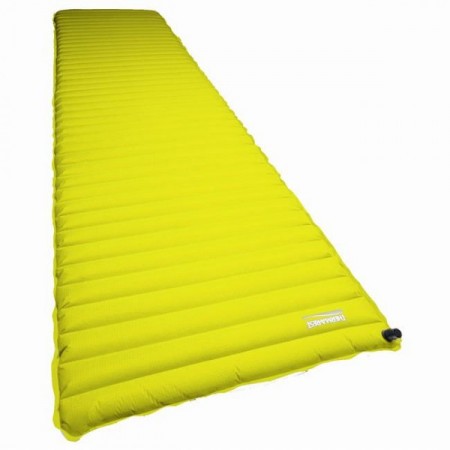 The latest sleeping pad from a long lineage of quality products in the Therm-a-rest line from Cascade Designs delivers on it promises. Forgoing the insulation and foam that generally fills sleeping pads, the Neo Air instead uses a reflective materiel to reflect heat back to the body. This move saves quite a bit of space and weight while still managing to give the Neo Air a respectable R-rating of 2.5. The pad weighs in at a mere 13.375oz., rolls up to the size of a one liter bottle and still raises you up 2.5" off the ground. Our testers found this to be the most comfortable mat by a healthy margin. Sleeping bags stay nicely on the mat without slipping off during the night and the horizontal design of the air chambers made for a great distribution of weight. As you would expect, the pad is constructed of very lightweight materials and gentle handling is the name of the game, although on the two week test in Glacier National Parkand Gunnison National Forest, the Neo Air showed no signs of a leak. There have been some reports of some early distribution problems but these should ease with time. If you are looking for the top of the line pad and can get past the sticker shock, the Neo Air is the only choice. If, on the other hand, you are looking for a great pad that is about half the price, albeit slightly heavier and more bulky, check out the Big Agnes Insulated Air Core. Also available in four sizes; small (20"x47"), medium (20"x66"), regular (20"x72"), and large (25"x77") there is a surely a size for everyone.
The latest sleeping pad from a long lineage of quality products in the Therm-a-rest line from Cascade Designs delivers on it promises. Forgoing the insulation and foam that generally fills sleeping pads, the Neo Air instead uses a reflective materiel to reflect heat back to the body. This move saves quite a bit of space and weight while still managing to give the Neo Air a respectable R-rating of 2.5. The pad weighs in at a mere 13.375oz., rolls up to the size of a one liter bottle and still raises you up 2.5" off the ground. Our testers found this to be the most comfortable mat by a healthy margin. Sleeping bags stay nicely on the mat without slipping off during the night and the horizontal design of the air chambers made for a great distribution of weight. As you would expect, the pad is constructed of very lightweight materials and gentle handling is the name of the game, although on the two week test in Glacier National Parkand Gunnison National Forest, the Neo Air showed no signs of a leak. There have been some reports of some early distribution problems but these should ease with time. If you are looking for the top of the line pad and can get past the sticker shock, the Neo Air is the only choice. If, on the other hand, you are looking for a great pad that is about half the price, albeit slightly heavier and more bulky, check out the Big Agnes Insulated Air Core. Also available in four sizes; small (20"x47"), medium (20"x66"), regular (20"x72"), and large (25"x77") there is a surely a size for everyone.
Quick Review:
Design: Light weight sleeping pad Weight: 13.375oz. (Regular) Retail: $119.95 - $169.95 (Buy) Why it's hot:
- Light weight
- Great weight distribution
- Great loft
- Packs down small
Why it's not:
- Price
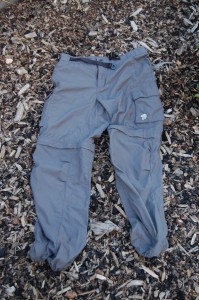 There are dozens of options for convertible pants from nearly every clothing manufacturer. For this test, I tried the Mesa Pants from Mountain Hardwear (MH). I’ve gained a little weight over the last year, but according to the USAF my waist is still 33 inches. Going by the MH sizing chart, that puts me in the ‘medium’ range of pants. I ordered the long version to make sure the pants would be long enough. When they arrived I immediately tried them on and learned they’re a little snug. The medium size is supposed to fit up to a 34 waist, but that would be a very tight fit.
On our trek through the Raggeds Wilderness in August, these pants performed quite well. They are fairly water resistant, and dried very quickly when they did get wet. The built in drawcord cuffs helped keep the rocks & mud out of my boots since I wasn't wearing gaiters. The convertible feature is quick & easy to use, the zipper never got stuck at all. It would be helpful if there were some identifying marks on the pant bottoms, since I tried to zip the wrong side on nearly every time.
So far the pants have worn pretty well, but they only have about 50 miles on them so far. The seams are holding just fine, despite the snug fit. The pockets are just right, and managed to hold all of my electronics & other necessities great on the trail. One issue I did notice is that the built-in belt does not hold very well. I had to tighten the slip-through buckle at nearly every stop.
These are a great pair of pants for light backpacking in fair weather. They’re not insulated so I won’t be using them for winter trekking, but they’ve worked well all summer. Since they run a little small, if you’re on the high end of a size, consider getting the next size up.
Quick Review
Design:
There are dozens of options for convertible pants from nearly every clothing manufacturer. For this test, I tried the Mesa Pants from Mountain Hardwear (MH). I’ve gained a little weight over the last year, but according to the USAF my waist is still 33 inches. Going by the MH sizing chart, that puts me in the ‘medium’ range of pants. I ordered the long version to make sure the pants would be long enough. When they arrived I immediately tried them on and learned they’re a little snug. The medium size is supposed to fit up to a 34 waist, but that would be a very tight fit.
On our trek through the Raggeds Wilderness in August, these pants performed quite well. They are fairly water resistant, and dried very quickly when they did get wet. The built in drawcord cuffs helped keep the rocks & mud out of my boots since I wasn't wearing gaiters. The convertible feature is quick & easy to use, the zipper never got stuck at all. It would be helpful if there were some identifying marks on the pant bottoms, since I tried to zip the wrong side on nearly every time.
So far the pants have worn pretty well, but they only have about 50 miles on them so far. The seams are holding just fine, despite the snug fit. The pockets are just right, and managed to hold all of my electronics & other necessities great on the trail. One issue I did notice is that the built-in belt does not hold very well. I had to tighten the slip-through buckle at nearly every stop.
These are a great pair of pants for light backpacking in fair weather. They’re not insulated so I won’t be using them for winter trekking, but they’ve worked well all summer. Since they run a little small, if you’re on the high end of a size, consider getting the next size up.
Quick Review
Design:
- Canyon™ Cloth, Lined with Micro-Chamois
- 14oz / 392g
- $74.95 (buy)
- Easily convertible
- Dry quickly
- Perfect pockets
- Sizing a little small
- Belt slips
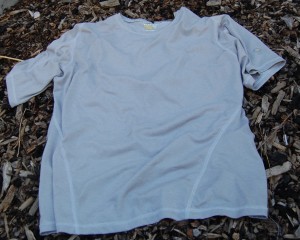 This shirt features a wicking anti-microbial fabric that’s very fast drying. This means less time for the sweat to soak in, and less odor. On our Raggeds Adventure, hiking to nearly 11,000 feet really put this shirt to the test. I’m glad to say that after three days of sweat & dirt, this shirt was still acceptable in a local restaurant in Gunnison.
Another great feature of this shirt is that the bottom seams are rotated toward the front, so your pack stays more comfortable. They’re also flat knitted, which is less likely to dig in to your skin. The fabric is pick-resistant, so even after quite a bit of off-trail trekking there were very few snags and the shirt held up great.
Quick Review
Design:
This shirt features a wicking anti-microbial fabric that’s very fast drying. This means less time for the sweat to soak in, and less odor. On our Raggeds Adventure, hiking to nearly 11,000 feet really put this shirt to the test. I’m glad to say that after three days of sweat & dirt, this shirt was still acceptable in a local restaurant in Gunnison.
Another great feature of this shirt is that the bottom seams are rotated toward the front, so your pack stays more comfortable. They’re also flat knitted, which is less likely to dig in to your skin. The fabric is pick-resistant, so even after quite a bit of off-trail trekking there were very few snags and the shirt held up great.
Quick Review
Design:
- 100% Polyester
- 5oz / 154g
- $44.95 (buy)
- Anti-Microbial (low odor)
- Well placed seams
- Durable
- A little pricey for a T-Shirt
Backpacking in the summer, regardless of where you go, means one thing: sweat. In the past the standard polyester shirts I’ve worn have had a major problem with odor. I really like the Merino Wool Patagonia shirts, but had concerns about their durability. Enter the Mountain Hardwear Duration S/S shirt.
This shirt includes features a wicking anti-microbial fabric that’s very fast drying. This means less time for the sweat to soak in, and less odor. On our Raggeds Adventure, hiking to nearly 11,000 feet really put this shirt to the test. I’m glad to say that after three days of sweat & dirt, this shirt was still acceptable in a local restaurant in Gunnison.
Another great feature of this shirt is that the bottom seams are rotated toward the front, so your pack stays more comfortable. They’re also flat knitted, which is less likely to dig in to your skin. The fabric is pick-resistant, so even after quite a bit of off-trail trekking there were very few snags and the shirt held up great.
Quick Review
Design: 100% Polyester Weight: 5oz / 154g Retail: $44.95 (buy)
http://www.usoutdoorstore.com/outlet/mountain-hardwear-duration-ss-tee.html
Why It’s Hot: -Anti-Microbial (low odor) -Well placed seams -DurableWhy It’s Not: -A little pricey for a T-Shirt
Backpacking in the summer, regardless of where you go, means one thing: sweat. In the past the standard polyester shirts I’ve worn have had a major problem with odor. I really like the Merino Wool Patagonia shirts, but had concerns about their durability. Enter the Mountain Hardwear Duration S/S shirt.
This shirt includes features a wicking anti-microbial fabric that’s very fast drying. This means less time for the sweat to soak in, and less odor. On our Raggeds Adventure, hiking to nearly 11,000 feet really put this shirt to the test. I’m glad to say that after three days of sweat & dirt, this shirt was still acceptable in a local restaurant in Gunnison.
Another great feature of this shirt is that the bottom seams are rotated toward the front, so your pack stays more comfortable. They’re also flat knitted, which is less likely to dig in to your skin. The fabric is pick-resistant, so even after quite a bit of off-trail trekking there were very few snags and the shirt held up great.
Quick Review
Design: 100% Polyester Weight: 5oz / 154g Retail: $44.95 (buy)
http://www.usoutdoorstore.com/outlet/mountain-hardwear-duration-ss-tee.html
Why It’s Hot: -Anti-Microbial (low odor) -Well placed seams -DurableWhy It’s Not: -A little pricey for a T-Shirt


